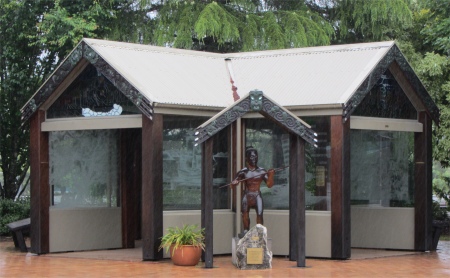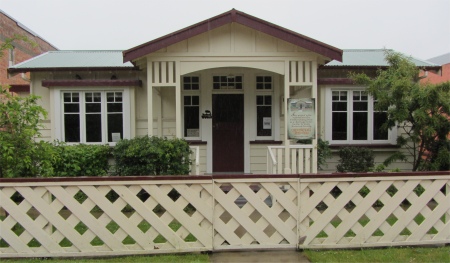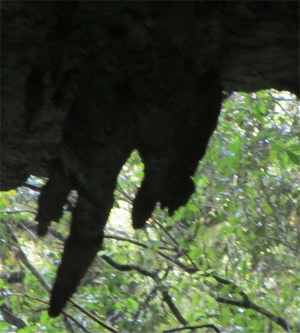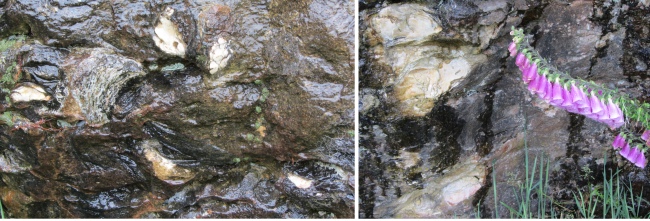
Trust Waikato Millennium Pavilion
|
It poured all night, but fortunately the Mangaokewa Stream did not flood over its banks; I was parked only 4m away. It was 05:30 when I awoke, and I looked outside, but the drumming on the roof told me all I wanted to know about the state of the weather. I eventually picked up courage to sprint to the washrooms, and that really did wake me up.

Heritage Cottage
|
After mulling over my options, I headed into downtown Te Kuiti. Almost all the small businesses, shops and eateries/cafes were on the east side of the main highway, Rora Street. The rail track was on the west side, and I actually saw a train today, perhaps the only train.
I breakfasted in the Central Cafe, there was no way I was going to soak the interior of the car sorting breakfast out in camp. The cafe was a busy enterprise and a focal point for a lot of the locals. I pushed the boat out and gorged myself on bacon and eggs, then sipped coffee while I finished off some typing. Outside the rain poured incessantly. Paint was peeling off a sign under the sheltered walkway, and sparrows flew sorties below the ceiling of the walkway, stopping off at their small resting holes which were betrayed by remnants of ancient straw dangling down.

Mangapohue Natural Bridge
|
After having walked the length and breadth of the town in under ten minutes, I crossed over to the information office. "What is there to do on a rainy day in Te Kuiti?" I asked the manageress. She laughed, "There is not a lot, people come here to do a lot of walking." Out came a brochure and she pointed out the Pavilion and Heritage Cottage.
I thanked her and waved bye as I joked about the glorious weather we were having; she was well used to it. The Trust Waikato Millennium Pavilion (Te Kuititanga O Nga Whakaaro) was a short distance away. This open structure was opened 12 years ago to celebrate the town's people, heritage and history. It comprised glass walls on which images and text were etched depicting Maori and Pakeha history, local history, local dignitaries and what makes the town tick today in terms of its young people, sport and industry. What was remarkable was the absence of vandalism or graffiti on this open construction.
On my way across to the Heritage Cottage, a young fellow came up to me with a clipboard and Greenpeace emblazoned across his T-shirt. He brought to my attention the New Zealand government's plans to allow foreign companies to exploit the oil fields off the coastline, in return for a 5% share of the gains. The lad wasn't concerned about whether this was a sound financial deal for the country, but his grief was related to the potential oil slick problems associated with such ventures. The wells would be much deeper than the BP platform that went awry in the Gulf of Mexico, and hence harder to fix if things did go pear-shaped. He also questioned the sanity of putting oil wells near major fault lines in the earth's crust. He had a point there. He was after signatures, but lost interest in my views when he found out I wasn't a Kiwi. Instead he encouraged me to lend my voice to the UK Greenpeace movement. Good on him I thought, you need folk like him to go out and inform people (the government certainly won't go out of its way on hot issues like this), and if he gets just a few people to start thinking, he has at least achieved something.

Biokarst
|
I arrived at the Heritage Cottage a little too early, and stood there under the dripping walkway like one o'clock half struck. I must have looked a comical sight in my wet shorts and dripping waterproof top. For some unknown reason, a woman stopped to chat with me, she was looking for her friends. She was quite excited about the rain. Being a farmer, she had experienced problems during the recent drought, but now she was over the moon; understandably. I need to get my mind tuned more to farmer mode.
At last the Heritage Cottage was open. This railway cottage, complete with furnishings and memorabilia, had been fully restored to its former glory. It started life on Te Kumi Road where it spent many years as a family dwelling. In 2006 a local gentleman by the name of John Barton donated the cottage to the Te Kuiti and Districts Historical Society, who undertook the restoration project.
Jackie, the lady in charge for the morning, showed me around the cottage. The kitchen very much resembled my grandmother's kitchen, where meals could be cooked by the hearth, and food would be kept in a small pantry. The outside wash house took me back to my childhood. The main difference was my mother used to use a dolly stick in a dolly tub to agitate the clothes; that feature had not arrived here by the looks of it. Jackie, who obviously read a lot of history books, had heard of such contraptions though. All in all the wooden cottage resembled a single storey version of what my ancestors once lived in in my mining village, a two up/two down terrace house. I explained to her that when I examined the census records for my ancestors for those times, a couple with eight kids and a few lodgers shared this terraced house. She smiled, and we both knew that today's generations don't know how lucky they are. We discussed our respective travelling adventures, car insurance, how our respective health services are used and abused, and more besides. It became evident that the lady had "historian" running all the way through her. The subject of earthquakes cropped up, they happen quite frequently in these parts. Indeed one had occurred recently near where her daughter lives. Jackie regarded it as not minor, and rang her daughter up to check all was OK. "It's OK mum," said the daughter consoling mum over the phone, "We felt it, but nothing happened, so we sat down again and carried on as normal." We discussed the drought and rain at length. Michael, her husband, appeared. He was hoping to do some tramping with his son, but was holding out until Sunday when the weather might improve. I mentioned I wanted to do some walking down the Te Anga Road. "Just go for it, they are short walks, and the falls will be in good spate today." That was the prod that I needed. They were a happy couple, both adventurous and keen to get out and just do it. I thanked them and headed off into the torrents.

Fossilised Oysters
|
My route took me back past the Waitomo complex and down the long Te Anga Road, today mainly occupied by convoys of logging trucks. This was a winding road, up hill and down dale. A tip for those wishing to visit these islands: when estimating driving times for non-motorway roads, do a quick estimate, then double it. A long way down I pulled in to the Mangapohue Natural Bridge Scenic Reserve. Fortunately down here I had some respite from the vertical torrents of rain; they were now horizontal. It was then a case of hiking along the short trail that followed the coffee coloured Mangapohue Stream (though it looked more like a river today), until I reached a 17m high limestone arch, the Mangapohue Natural Bridge, that once made up part of the entire cave system around the Waitomo area. The arch is a result of water erosion, unlike the arches I saw in
Arches National Park, all of which were a result of wind erosion. What was unusual about the underside of the arch was the stalactite-like structures. These fascinating features are known as "epitrophic speleothems" or "biokarst". They are not quite the same as the stalactites that can be seen in caves. The features here were created by rain water dripping through the limestone roof of the bridge, dissolving limestone along the way. Mosses and algae growing on the bridge's ceiling absorb the water as it reappears. As the plants grow towards the light, the dissolved limestone is left behind in ever-growing, strangely shaped stacks. Jackie had informed me that the underside of the arch is spectacular at night with its own constellations of glowworms, though I didn't hang about for that pleasure. I continued along a loop trail to discover 30-million-year-old fossilised oysters exposed in limestone outcrops.

Striking Rock Formation
|
Further on along the Te Anga Road, I pulled in at a car park and headed up a dripping trail to the Marokopa Falls. I can now say I have experienced a rain forest with plenty of rain; it added to the atmosphere. These magical falls stood at a height of 36m and had several rocky ledges for the water to cascade over, and my were they in full spate today. There was a real sense of power from these falls, much more than the Bridal Veil Falls I had seen yesterday. A young couple from Pembrokeshire were trying to capture a picture of the falls and the rain together. Not too sure that would come out on the photo. What really set these falls off as one of the most dramatic in the country was the surrounding jungle-like rainforest of pukarea, tawa and kohekohe trees, and as I said earlier, all absolutely dripping wet.
I was absolutely soaked by this time, and it is at times like this where the wee problems of travelling the way I do start to strike home. I now have a car full of wet clothes, and the windows consequently always steam up. I can live with that, but I look forward to the time when I can pull everything out and give it all a good airing; bedding and all. Maybe in a weeks' time, hopefully before Christmas.
I returned to the same campsite since I have not many options open to me. Basically I am killing time until the weather picks up; all my activities in the near future involve being outside. Te Kuiti may not be the centre of the universe, but it is a long way to any other civilisation.

Marokopa Falls in Full Spate
|
I met a couple in the communal kitchen who were watching the American version of the X Factor. It seems that if a series is repeated from the UK to the US, the New Zealanders always get the US version. Otto, who moved from Berlin 46 years ago, and his wife were from Christchurch. Their house had suffered damage during the earthquake, the chimney having fallen down through the roof, and numerous cracks appeared around walls and the hearth. They considered themselves lucky; across the road from them houses literally sunk into the ground. They had to live with no sewage and water connection systems for five weeks; potties and a dump station were the order of the day. Their chimney had been repaired on the insurance; all repairs across the city were being carried out on an emergency rating system, and holes in roofs and chimneys featured higher up the pecking order. Apparently all property insurances have an element of house insurance, contents insurance PLUS an element of earthquake insurance. They told me how they recently tried to visit as close to the city centre as they were allowed, before reaching the keep-out barriers. The devastation is so bad that they had difficulty finding their way around; all the landmarks had gone. It is not just the visible destruction above the ground, most of the services in the ground such as water, sewage etc. have been destroyed, and a major exercise is on-going to repair these services. The storm water systems are of some concern, since the river has now risen above the level of those systems. There has been so much destruction down there, and some areas have been so badly affected, that they have been declared no-go zones and no more properties will ever be built there. A 160m high British crane, the world's tallest apparently, is currently involved in dismantling a 23 storey hotel. It is a sorry tale indeed, but this couple seem to have got over it and are still content to carry on living there.
Their TV program finished and off they went back to their campervan. I too turned in, looking forward to another damp day tomorrow.







